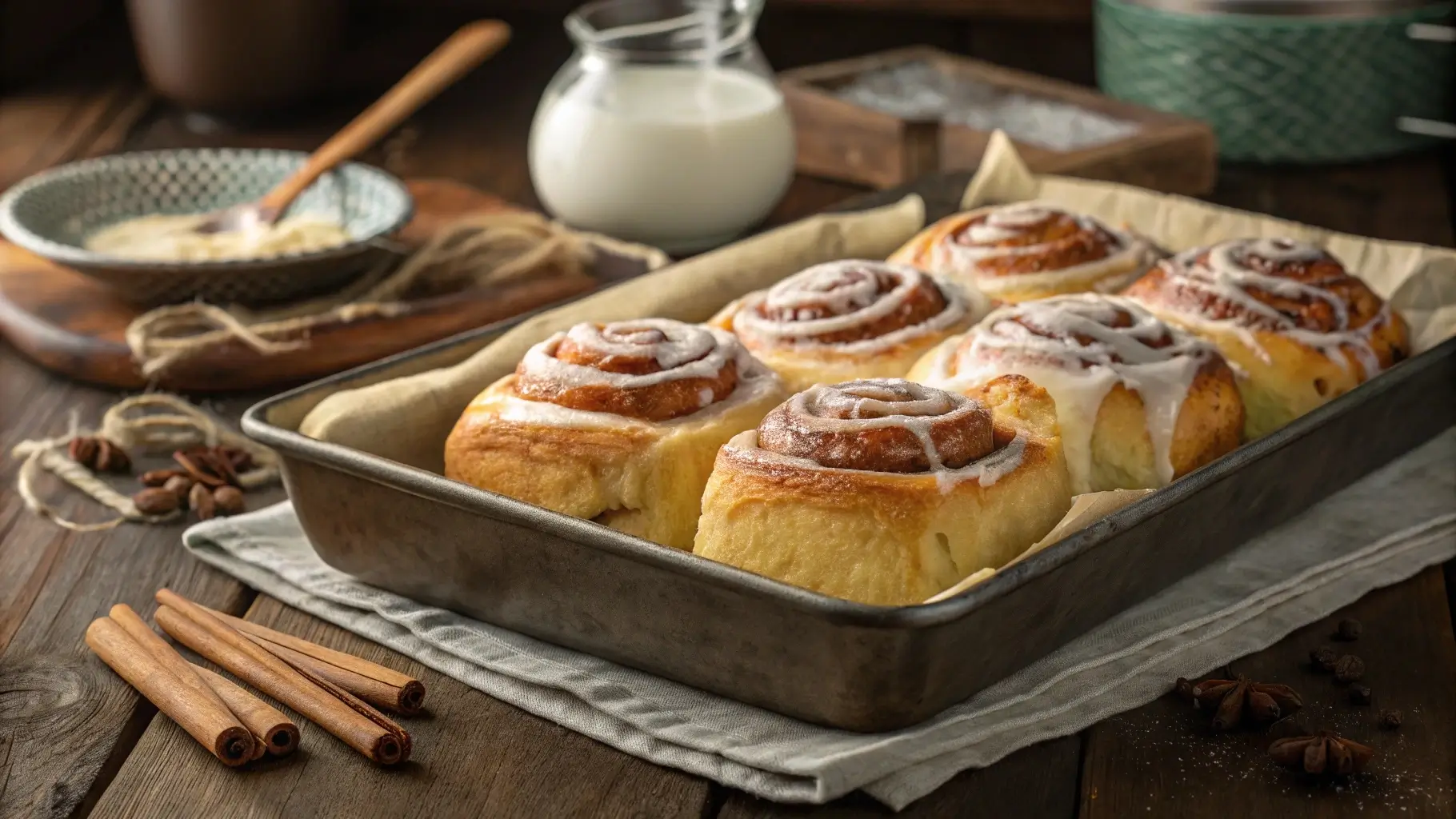Table of Contents
Who doesn’t love the warm, gooey goodness of cinnamon rolls? Now, imagine adding a tangy twist to that classic flavor with a sourdough cinnamon rolls recipe! Combining the soft, fluffy texture of a well-proofed dough with the bold flavors of cinnamon and sugar, these rolls are sure to become your new favorite bake.
In this guide, we’ll walk you through every step of creating these mouthwatering rolls. From preparing the perfect sourdough starter to crafting the filling and glaze, this comprehensive recipe will ensure your rolls turn out just right. We’ll also cover tips for troubleshooting, fun variations, and FAQs to help you master the art of sourdough baking.
Whether you’re a seasoned baker or a newbie looking to try your hand at homemade cinnamon rolls, this step-by-step guide will help you bake like a pro. Let’s roll up our sleeves and dive into the world of fluffy, tangy, and irresistible sourdough cinnamon rolls!
Introduction to Sourdough Cinnamon Rolls
What Makes Sourdough Cinnamon Rolls Unique?
Why are sourdough cinnamon rolls so special? Unlike traditional cinnamon rolls, the dough for this recipe is leavened with a sourdough starter. This gives the rolls a slightly tangy flavor, which beautifully balances the sweetness of the cinnamon-sugar filling. The natural fermentation process also makes the rolls softer, fluffier, and easier to digest—making them a hit for any occasion.
Plus, sourdough adds depth to the overall flavor, creating a rich and complex taste that’s hard to beat. It’s not just about the flavor, though. Baking with sourdough feels like a small kitchen adventure, especially when you see your starter come to life!
Why Choose Sourdough Over Traditional Dough?
Sourdough isn’t just about the flavor—it’s about the process. Traditional cinnamon rolls rely on commercial yeast for a quick rise, but sourdough takes its time. This longer fermentation allows the flavors to develop naturally while improving the dough’s texture and structure.
Not to mention, using sourdough can be a more wholesome option. The fermentation process breaks down some of the gluten and starches, making it gentler on your stomach. If you’ve got a sourdough starter sitting in your kitchen, this recipe is the perfect way to put it to good use.
Key Ingredients for Sourdough Cinnamon Rolls Recipe
Essential Ingredients for the Dough
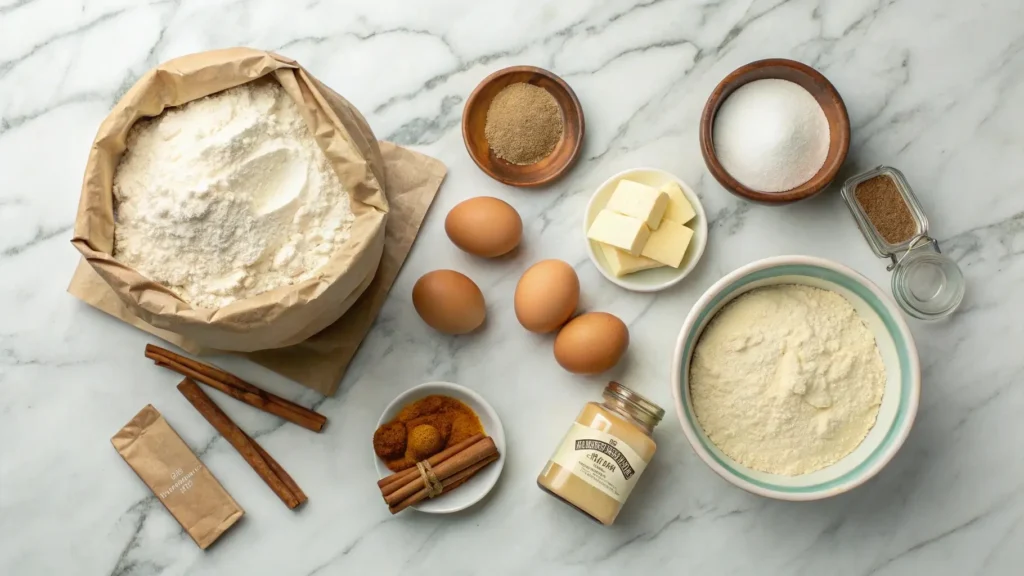
Making the perfect sourdough cinnamon rolls recipe starts with the right ingredients. Here’s what you’ll need for the dough:
- Sourdough Starter: Whether active or discard, the starter is the heart of this recipe, adding that signature tangy flavor.
- All-Purpose Flour: Ensures a soft, fluffy texture that holds up during baking.
- Milk: Warm milk activates the starter and enriches the dough’s softness.
- Butter: Adds a rich, buttery flavor and keeps the rolls tender.
- Eggs: Enhance the dough’s structure and create a light texture.
- Sugar: Provides sweetness and helps the rolls brown beautifully.
The Perfect Filling for Cinnamon Rolls
The filling is where the magic happens! Here’s what you’ll need:
- Brown Sugar: Adds depth and caramel-like sweetness.
- Cinnamon: The star ingredient for that classic warm, spicy flavor.
- Butter: Softened butter helps the filling spread evenly.
- Optional Additions: Raisins, nuts, or even chocolate chips for a fun twist!
Choosing the Best Toppings or Glaze
Topping your cinnamon rolls with a glaze takes them to the next level. Cream cheese frosting is a popular choice, offering a tangy, sweet finish. Alternatively, you can drizzle a simple powdered sugar glaze or even a maple syrup glaze for extra indulgence.
Preparing the Sourdough Starter
What Is a Sourdough Starter and How Does It Work?
A sourdough starter is a natural leavening agent made from flour and water. When left to ferment, wild yeast and bacteria develop, creating the base for this sourdough cinnamon rolls recipe. The fermentation not only gives the dough its tangy flavor but also helps it rise without using commercial yeast.
Steps to Prepare an Active Sourdough Starter for This Recipe
- Feed Your Starter: If you have an existing starter, feed it with equal parts flour and water about 4–6 hours before baking.
- Check for Readiness: Your starter is ready when it’s bubbly and has doubled in size. A quick float test (dropping a small amount into water) will confirm its activity.
- Measure the Starter: Use the specified amount in the recipe and return the rest to its storage container.
Can You Use Sourdough Discard for Cinnamon Rolls?
Yes! If you don’t have an active starter, sourdough discard works just as well. While it won’t add as much rise, it still delivers a tangy flavor. Simply adjust the recipe by adding a bit of commercial yeast for extra leavening.
Step-by-Step Instructions for Making Sourdough Cinnamon Rolls
Preparing the Dough
The first step to creating the best sourdough cinnamon rolls recipe is making the dough. Follow these steps for a perfect result:
- Activate the Starter: Ensure your sourdough starter is bubbly and ready to use. If it’s not active, feed it a few hours before starting.
- Mix the Dough: In a large bowl, combine warm milk, active starter, eggs, melted butter, sugar, and salt. Slowly add flour while mixing until a soft, sticky dough forms.
- Knead the Dough: Knead on a floured surface or use a stand mixer with a dough hook until smooth and elastic. This process usually takes 8–10 minutes.
- First Rise: Place the dough in a greased bowl, cover with a damp cloth, and let it rise for 4–6 hours at room temperature or overnight in the refrigerator.
Rolling and Filling the Dough
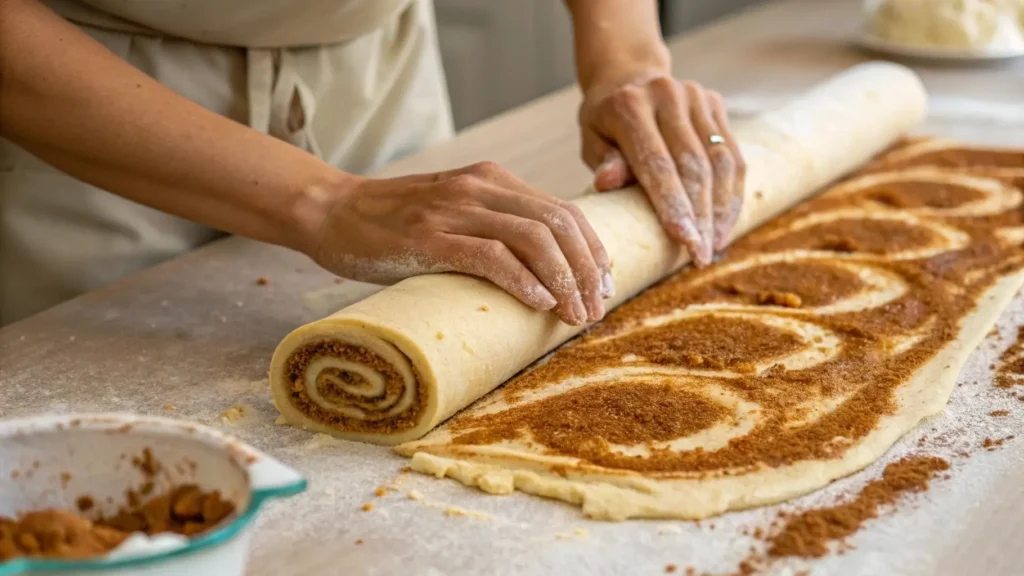
Once the dough is ready, it’s time to roll and fill:
- Roll Out the Dough: On a floured surface, roll the dough into a rectangle, about 1/4-inch thick.
- Spread the Filling: Combine softened butter, brown sugar, and cinnamon in a small bowl. Spread this mixture evenly over the dough.
- Roll and Slice: Starting from one long edge, roll the dough tightly into a log. Use a sharp knife or dental floss to cut the log into evenly sized rolls.
Cutting and Proofing the Rolls
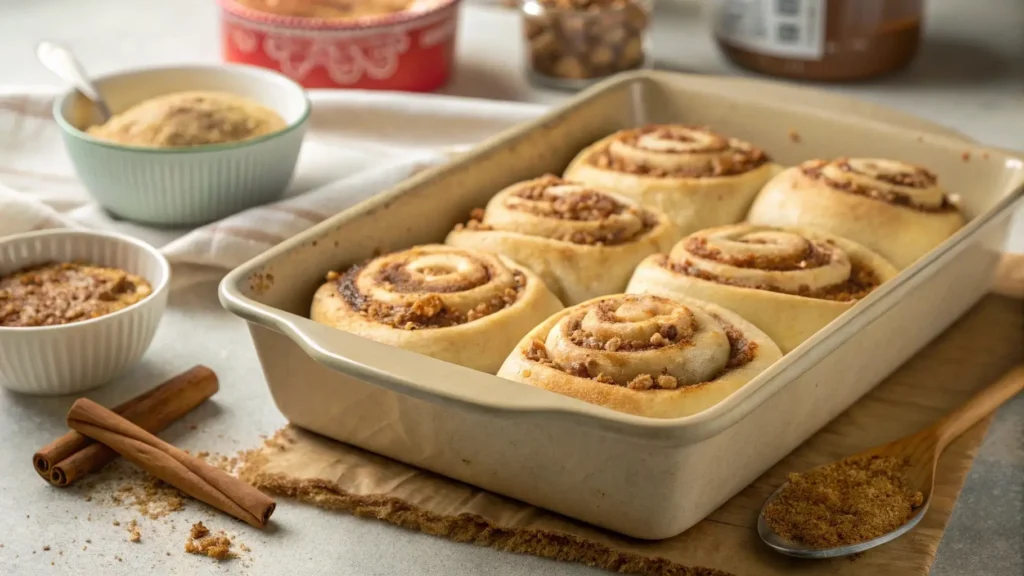
- Arrange the Rolls: Place the rolls in a greased baking dish, leaving a little space between them for expansion.
- Second Rise: Cover the dish with a towel and let the rolls proof for 1–2 hours until they’re puffy and almost doubled in size.
Baking the Rolls to Perfection
- Preheat and Bake: Preheat your oven to 375°F (190°C). Bake the rolls for 20–25 minutes until golden brown on top.
- Cool and Glaze: Let the rolls cool slightly before drizzling your favorite glaze over the top.
For additional baking tips, explore How to Make Perfect Brown Gravy Recipe in Just 10 Minutes.
Tips for Success
How to Avoid Dense or Dry Cinnamon Rolls
One common issue with cinnamon rolls is dense or dry dough. To avoid this, always ensure your starter is active and bubbly. Overproofing or underproofing can also affect texture, so keep an eye on the dough during both rises. Additionally, don’t skimp on the butter or milk—these add richness and moisture.
Common Mistakes and How to Fix Them
- Overloading the Filling: While it’s tempting to pile on the sugar and cinnamon, too much filling can seep out and cause the rolls to stick. Stick to the recommended amounts.
- Skipping the Rest Period: Resting the dough in the refrigerator overnight allows flavors to develop fully. Don’t skip this step if time allows.
- Cutting the Rolls Unevenly: For uniform baking, use a ruler to measure and cut even slices. Dental floss works great for clean cuts without squishing the dough.
Timing Tips for Overnight or Same-Day Baking
- For overnight rolls, proof the dough in the refrigerator after shaping. Bake them fresh in the morning for the best flavor and texture.
- If you’re short on time, let the rolls rise at a warm room temperature and bake them the same day. Just note that the flavor may be slightly less tangy without the extended fermentation.
Variations of Sourdough Cinnamon Rolls

Vegan or Dairy-Free Sourdough Cinnamon Rolls
Want to make your sourdough cinnamon rolls recipe vegan or dairy-free? It’s easier than you think! Swap regular milk for plant-based alternatives like almond, oat, or soy milk. Replace butter with vegan butter or coconut oil, and use flaxseed meal mixed with water as an egg substitute. The rolls will still be fluffy and flavorful, but with a plant-based twist.
Adding Nuts, Raisins, or Chocolate to Your Rolls
If you want to take your cinnamon rolls up a notch, consider mixing in some fun additions. Sprinkle chopped pecans, walnuts, or almonds over the filling for added crunch. For a touch of sweetness, add raisins or dried cranberries. If you’re a chocolate lover, sprinkle mini chocolate chips into the filling for a rich, decadent treat.
Experimenting with Spices Beyond Cinnamon
Cinnamon is classic, but why stop there? Try blending in other spices like nutmeg, cardamom, or even pumpkin pie spice to create unique flavor profiles. These small tweaks can transform your sourdough cinnamon rolls recipe into something truly special.
Serving and Storage Tips
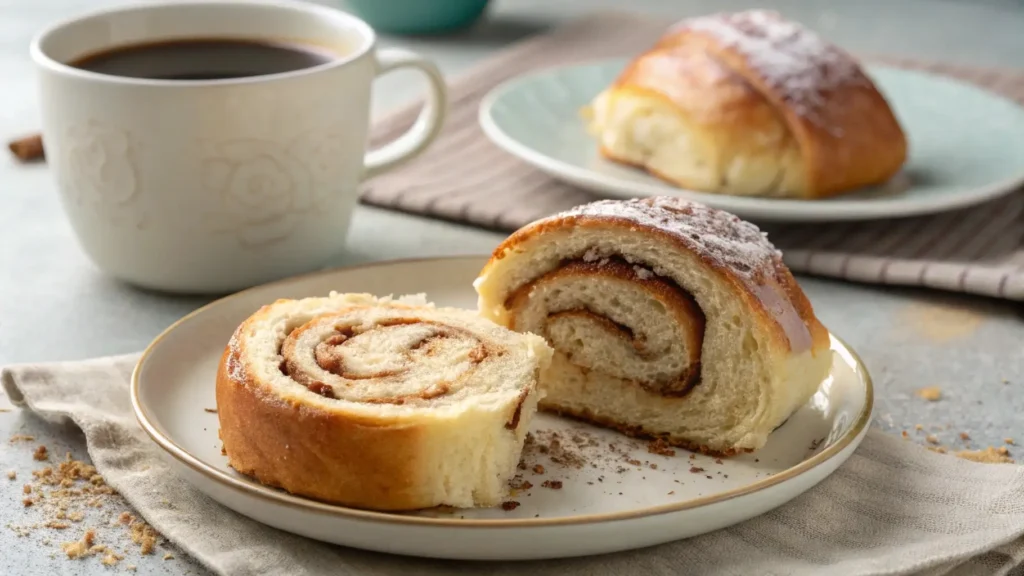
The Best Way to Serve Sourdough Cinnamon Rolls
Fresh out of the oven, these cinnamon rolls are best served warm with a generous drizzle of glaze or frosting. For a classic touch, use a cream cheese frosting that complements the tangy flavor of the sourdough. If you’re serving them as part of a brunch spread, pair them with fresh fruit, coffee, or even mimosas for a complete meal.
How to Store and Reheat Cinnamon Rolls
If you have leftovers (though it’s unlikely!), you can store your sourdough cinnamon rolls recipe in an airtight container at room temperature for up to two days. For longer storage, keep them in the fridge for up to a week or freeze them for up to three months.
To reheat, pop a roll into the microwave for 20–30 seconds or warm it in the oven at 300°F (150°C) for about 10 minutes. For frozen rolls, let them thaw overnight in the fridge before reheating.
These tips ensure your cinnamon rolls stay just as soft and delicious as when they were first baked!
Frequently Asked Questions (FAQs)
Can You Freeze Sourdough Cinnamon Rolls?
Absolutely! Freezing is a great way to prepare your sourdough cinnamon rolls recipe in advance or store leftovers for later. After shaping the rolls but before baking, place them on a baking sheet and freeze until solid. Then, transfer the rolls to an airtight container or freezer bag. When ready to bake, thaw the rolls in the fridge overnight, let them proof, and bake as usual.
If the rolls are already baked, freeze them without frosting. Reheat in the oven at 300°F (150°C) until warm, and then add your glaze or frosting.
How Long Does the Dough Need to Proof?
The proofing time for your sourdough cinnamon rolls recipe depends on the temperature of your kitchen. For the first rise, plan for 4–6 hours at room temperature or overnight in the refrigerator. The second rise, after shaping, usually takes 1–2 hours. Keep an eye on the dough—when it’s puffy and almost doubled in size, it’s ready to bake.
Can You Make Sourdough Cinnamon Rolls Without a Mixer?
Yes, you can make this recipe entirely by hand! Mixing the dough with a sturdy spoon or spatula works well. Once combined, knead the dough on a lightly floured surface until it’s smooth and elastic. While it might take a little extra effort, the result is just as delicious.
What’s the Best Way to Make Fluffy Rolls?
The secret to fluffy cinnamon rolls lies in proper proofing and handling the dough gently. Avoid adding too much flour while kneading, as this can make the rolls dense. Ensuring your sourdough starter is active and bubbly also plays a big role in achieving soft, fluffy rolls.
Why You Should Try This Sourdough Cinnamon Rolls Recipe
Baking your own sourdough cinnamon rolls recipe is not just about the flavor—it’s about the experience. From watching your sourdough starter work its magic to enjoying the rich, tangy sweetness of the finished rolls, every step is rewarding. Whether you’re baking for your family, a holiday brunch, or just because you’re craving something special, this recipe is sure to impress.
